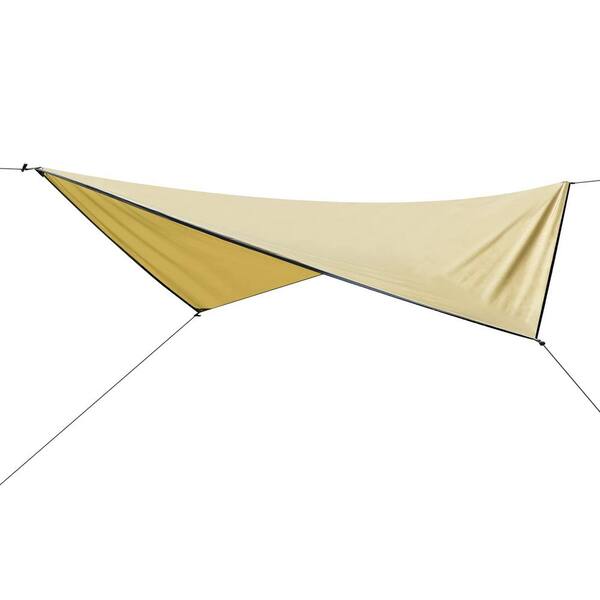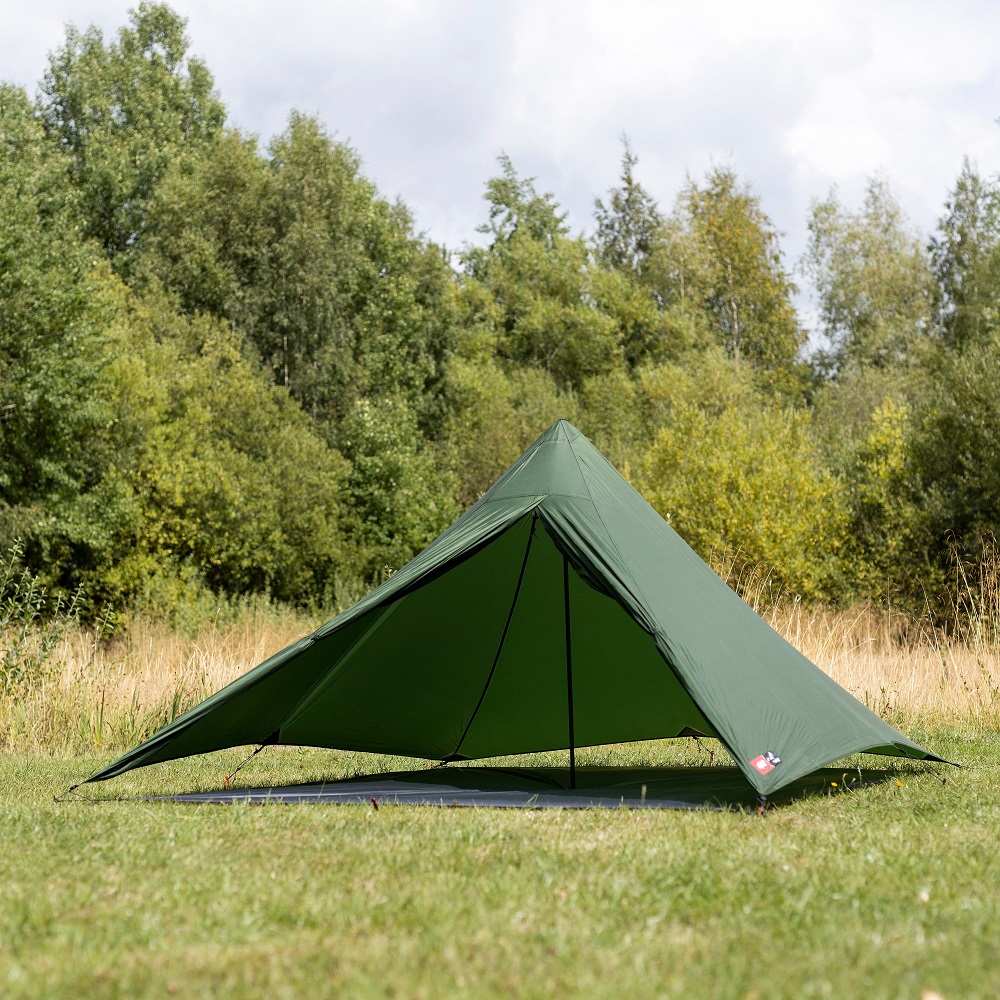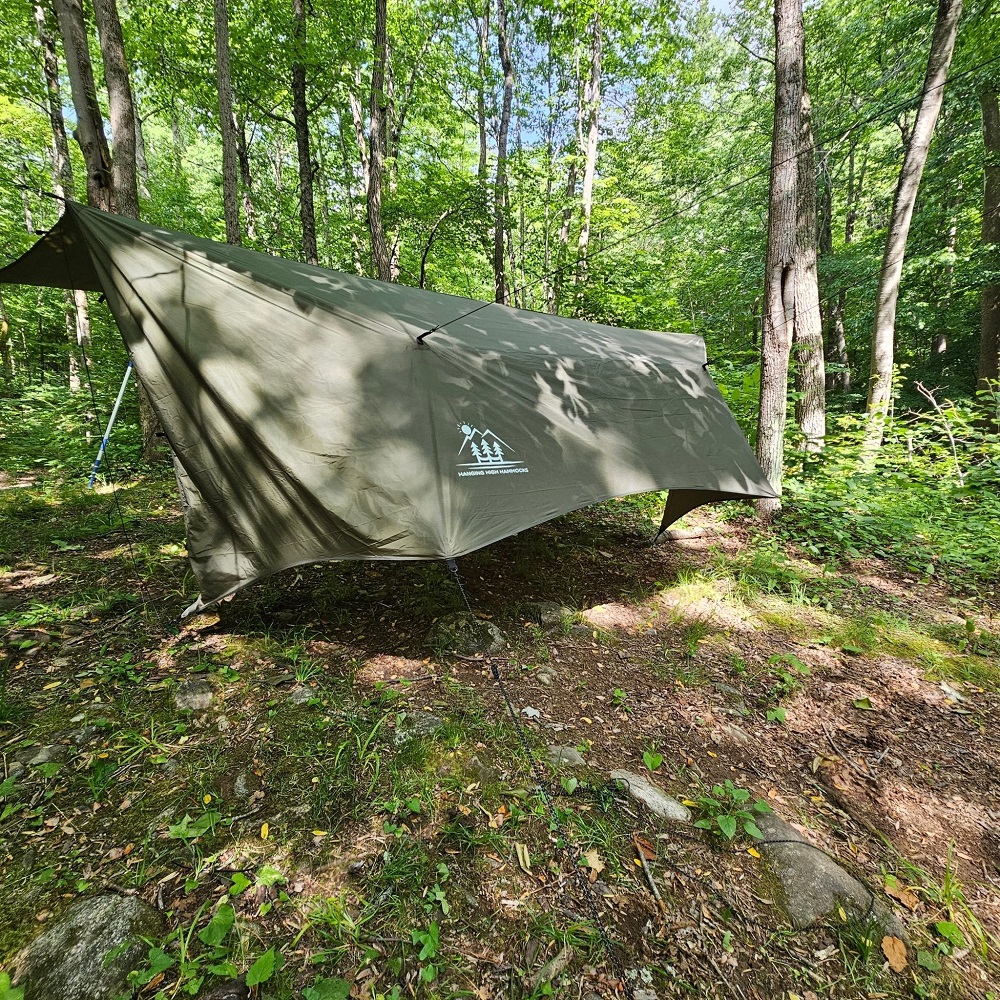Benefits of Using a Camping Tarp
Camping tarps are versatile and valuable tools for outdoor enthusiasts. They can greatly enhance your camping experience by providing essential protection and functionality in various conditions. Below, let’s explore the top benefits of using a camping tarp in your outdoor adventures.
Protection from Weather Elements
A camping tarp provides effective protection against rain, wind, and sun. When set up properly, it serves as a reliable shelter during unexpected downpours. It can keep you dry, safeguarding both you and your gear. During hot sunny days, it can act as a shade, reducing the impact of harmful UV rays. In windy conditions, a tarp can create a windbreak, giving you a more comfortable space. Its adaptability to different weather makes it an essential item in any camping kit.
Versatility in Outdoor Settings
Camping tarps excel in versatility, offering multiple uses in outdoor settings. They can function as a groundsheet, keeping your belongings off wet or dirty surfaces. You can also use them as a cooking shelter or dining area, ensuring a comfortable camping experience. Their lightweight and adjustable nature allow quick reconfiguration based on your needs. From serving as a hammock cover to creating extra sleeping spaces, tarps adapt to many scenarios. This flexibility makes them a must-have for both simple camping trips and complex outdoor adventures.

Choosing the Right Tarp
Selecting the right camping tarp is crucial for a successful outdoor adventure. You need to consider its material and durability, as well as its size and shape. These factors directly affect how well the tarp performs in different camping scenarios.
Material Options and Durability
The material of a camping tarp significantly impacts its performance and longevity. Common materials include nylon, polyester, and polyethylene. Nylon tarps are lightweight and strong, ideal for backpacking trips. Polyester is UV-resistant and offers durability for prolonged exposure to the sun. Polyethylene tarps are waterproof and robust, best suited for heavy-duty use.
Check for reinforced edges and quality stitching. These features improve durability and prevent wear and tear. Consider lightweight fabrics for easy transport, but balance that with your durability needs. Always prioritize materials that match your expected weather conditions and terrain.
Size and Shape Considerations
The size and shape of the tarp determine its usability. Large tarps provide more coverage, suitable for group camping or communal spaces. Small tarps are more portable, great for solo backpacking trips. Adjustable tarps can fit varying space requirements and adapt to different setups.
Shapes include rectangular, square, and hexagonal options. Rectangular tarps work well for simple shelters. Hexagonal tarps offer better aerodynamic performance in windy conditions. Choose a size and shape based on your camping style and available space. Always ensure the tarp is large enough to meet your specific needs, whether for sleeping, cooking, or gear protection.

Setting Up Your Tarp
Setting up a camping tarp effectively depends on the tools and techniques you use. A proper setup ensures durability, coverage, and comfort during your outdoor adventure. Let’s explore the gear you need and common configurations.
Essential Gear and Tools
Having the right gear simplifies tarp setup and improves its stability. Here’s a list of essentials:
- Tarp: Choose a durable and waterproof camping tarp that suits your needs.
- Ropes and Paracords: Sturdy cords help secure the tarp to anchors or trees.
- Tent Stakes: Use stakes to anchor tarp corners firmly into the ground.
- Poles: Adjustable poles provide elevation and versatility for different setup designs.
- Carabiners: Quick-release carabiners simplify attaching ropes to tarp loops.
- Mallet or Hammer: These are useful for driving stakes into firm or rocky soil.
- Ground Sheet: A groundsheet adds extra protection against moisture and debris.
Carry all gear in a compact bag for easy transport. Test your tools at home before an outdoor trip.
Common Tarp Configurations
Camping tarps can be set up in many ways depending on the weather and terrain. Here are popular configurations:
- A-Frame Shelter: It’s quick to assemble and offers great wind and rain protection. Secure the tarp over a ridgeline between two trees.
- Lean-To Shelter: Ideal for shade and wind protection. Attach one edge of the tarp to trees or poles and secure the other to the ground.
- C-Shaped Shelter: Provides excellent side coverage. Anchor corners with stakes and elevate one side using poles.
- Flat Roof: Creates a shaded area for dining or cooking. Tie all corners of the tarp to trees or poles.
- Hammock Cover: Ideal for hammock users. Drape and secure the tarp above the hammock as overhead coverage.
Each configuration adapts to specific weather needs. Learn and practice different methods to build a reliable camping tarp setup.

Tips for Maximizing Tarp Usage
Camping tarps are flexible outdoor tools that can improve your camping experience significantly. To get the most out of your tarp, strategic usage is essential. Here are some key tips to enhance its functionality and lifespan.
Enhancing Ventilation and Comfort
Proper setup improves airflow under the tarp, ensuring better comfort during camping. Use elevated poles or tie the tarp higher for better ventilation. Open-sided configurations, such as lean-to or flat-roof setups, encourage airflow. Avoid closing all sides of the tarp unless required for weather protection.
Position the tarp to catch a cool breeze during hot weather. Add mosquito nets or screens alongside open setups to keep bugs out. If you’re using the tarp for shade, orient it to block the sun’s most intense rays.
Consider using lightweight adjustable ropes to maintain tension. This prevents sagging that can compromise airflow or comfort. A smart setup ensures the tarp remains functional in varying weather conditions.
Preventing Wear and Tear
Maintaining your tarp during use boosts its longevity. Begin by avoiding sharp and abrasive surfaces underneath it. Use a groundsheet to shield it from rocks and rough terrain. Prevent dragging the tarp across the ground to avoid punctures or tears.
Check tension regularly to prevent damage from overstretching. Adjustable ropes and reinforced edges help minimize wear. Inspect corners and loops frequently for early signs of stress or fraying. Patch any minor tears promptly using tarp repair tape.
During storage, ensure the tarp is clean and dry. Moist or dirty tarps deteriorate quicker. Avoid folding it too tightly to prevent permanent creases, which can weaken the material. Following care steps ensures durability and continued usefulness of your camping tarp.
Camping Scenarios Best Suited for Tarps
Camping tarps are incredibly versatile and adapt to a variety of outdoor settings. Choosing the right camping tarp and configuration can enhance your experience in different scenarios. Here are some ideal situations where tarps prove invaluable.
Lightweight Backpacking
Camping tarps are perfect for lightweight backpacking. Their minimal weight makes them easy to carry. Unlike traditional tents, tarps take up less space in your backpack. This is crucial for long treks where every ounce matters.
Setup is quick and requires minimal effort. A-Frame or lean-to configurations work well for backpackers. These setups provide effective protection while remaining simple to construct. Tarps can also serve as ground covers, keeping your gear dry and clean.
Backpackers often face unpredictable weather. Tarps excel in these situations by offering fast and flexible shelter. You can adapt their setup to changing weather conditions on the trail.
Bushcraft and Survival Situations
Tarps are indispensable in bushcraft and survival situations. They offer quick shelter in emergencies. Bushcraft enthusiasts appreciate their adaptability in wild environments.
Use a tarp to craft various shelters like a C-shaped or A-frame structure. These provide protection from rain, wind, or extreme sunlight. In survival scenarios, their lightweight design allows for rapid deployment or relocation.
Tarps can also be used to collect rainwater for drinking. Lay the tarp at an angle to direct water flow into a container. You can create windbreaks or shade, improving comfort in challenging conditions. Their durability ensures they withstand rugged use, essential for bushcraft.
Carrying a good camping tarp ensures readiness for any outdoor adventure or survival challenge. This makes them an essential tool for effective outdoor preparedness.

Maintenance and Storage of Tarps
Proper maintenance and storage can prolong the lifespan of your camping tarp. Regular care helps keep it functional and ready for your next adventure. Here are essential tips for maintaining and storing your tarp effectively.
Cleaning and Care Tips
- Clean After Each Use: Always clean your tarp after every trip. Remove dirt, mud, and debris with water and a soft cloth. For stubborn stains, use mild soap but avoid harsh chemicals.
- Dry Thoroughly: Ensure your tarp is completely dry before storage. This prevents mold, mildew, and odor.
- Inspect Regularly: Check for tears, punctures, or weak seams after each use. Promptly patch small damages with tarp repair tape or kits.
- Avoid Excessive Sunlight: Prolonged UV exposure can weaken material. Use UV-resistant treatments if necessary. Store indoors when not in use.
- Protect Against Abrasion: Avoid placing it on sharp or rough surfaces. Lay down a groundsheet to shield the tarp from wear.
- Reapply Waterproofing: Over time, the waterproofing layer may wear off. Use waterproofing sprays or sealants to restore its water resistance.
By following these care practices, you can maintain your tarp in excellent condition for years.
Proper Folding and Storage Techniques
- Shake Off Debris: Shake off dirt, leaves, or sand before folding the tarp for storage.
- Fold Neatly: Fold the tarp evenly along its seams to prevent creases or weak spots. Avoid rolling it too tightly.
- Use a Storage Bag: Store the tarp in its original carry bag or a breathable container. Avoid plastic bags, as they trap moisture.
- Store in a Dry Place: Keep the tarp in a cool, dry location. Avoid humid areas like basements to prevent mold.
- Avoid Heavy Stacking: Do not stack heavy items on top of the tarp. This can damage the material or create permanent folds.
- Regular Air-Outs: If the tarp remains in storage for long periods, take it out occasionally. Let it air out to prevent odors or moisture buildup.
Proper storage ensures your camping tarp stays in top-notch condition, reducing the need for frequent replacements.
Top Camping Tarp Recommendations
Choosing the right camping tarp can significantly enhance your outdoor experience. With so many options, selecting a high-quality tarp becomes crucial. Below are top recommendations to help you make an informed decision.
Brands and Models Worth Considering
- MSR Thru-Hiker 70 Wing: Lightweight and durable, perfect for backpacking trips. Offers reliable weather protection.
- ENO ProFly Rain Tarp: Designed for hammock camping, this tarp is compact and waterproof.
- Aqua Quest Defender Tarp: Heavy-duty and versatile, great for both camping and survival scenarios.
- Kelty Noah’s Tarp: Features easy setup and multiple size options for group or solo campers.
- Hyperlite Mountain Gear Flat Tarp: Made of Dyneema fabric, it is ultra-light yet exceptionally strong.
When purchasing, consider these factors:
- Material quality for durability and weather resistance.
- Weight for portability during hikes.
- Size and shape flexibility for various setups.
These tarps come from trusted brands, ensuring performance in diverse outdoor conditions.
Budget-Friendly Options
- AmazonBasics Waterproof Camping Tarp: An affordable option with basic features for moderate camping needs.
- Uni-Shelter Lightweight Tarp: Compact and cost-effective, ideal for solo travelers and small spaces.
- Outdoor Products All-Purpose Tarp: Durable and versatile at a low price, great for beginner campers.
- Stansport Reinforced Ripstop Tarp: Provides good coverage at a reasonable cost.
- Wise Owl Outfitters Rain Tarp: Economical and lightweight, suitable for hammock camping on a budget.
Budget-friendly tarps are great for occasional use or entry-level camping. Despite lower cost, ensure they provide adequate weather protection and durability.
Choose a camping tarp based on your needs and camping style. Whether you’re backpacking solo or camping with a group, the right tarp ensures comfort and safety outdoors.

Embrace the Utility of Camping Tarps
Maximizing Your Outdoor Experience
In conclusion, camping tarps are versatile tools that can significantly enhance your outdoor experience. By understanding their features and learning how to use them effectively, you can maximize their utility. A well-managed tarp can transform your camping setup, providing shelter, comfort, and organization.
Investing in the Right Equipment
Investing in a quality camping tarp is a decision well worth considering. With the right tarp, you can face unexpected weather changes confidently while enjoying outdoor activities. The sense of security and versatility offered by a tarp helps you focus on the beautiful surroundings rather than day-to-day concerns.
Embracing Adventure
As you venture into the great outdoors, remember that every camping trip is a chance for adventure. The joy of camping often lies in the spontaneous experiences shared with friends and family. Embrace the journey, and let your camping tarp be a reliable companion in your adventures.
Create Lasting Memories
Ultimately, the memories created during your camping trips are what matter most. Make the most of your time outdoors by utilizing your camping tarp effectively. With proper care and creative usage, this essential piece of gear will serve you well for many adventures to come. Embrace the spirit of exploration, enjoy the beauty of nature, and create lasting memories with your camping tarp by your side.
